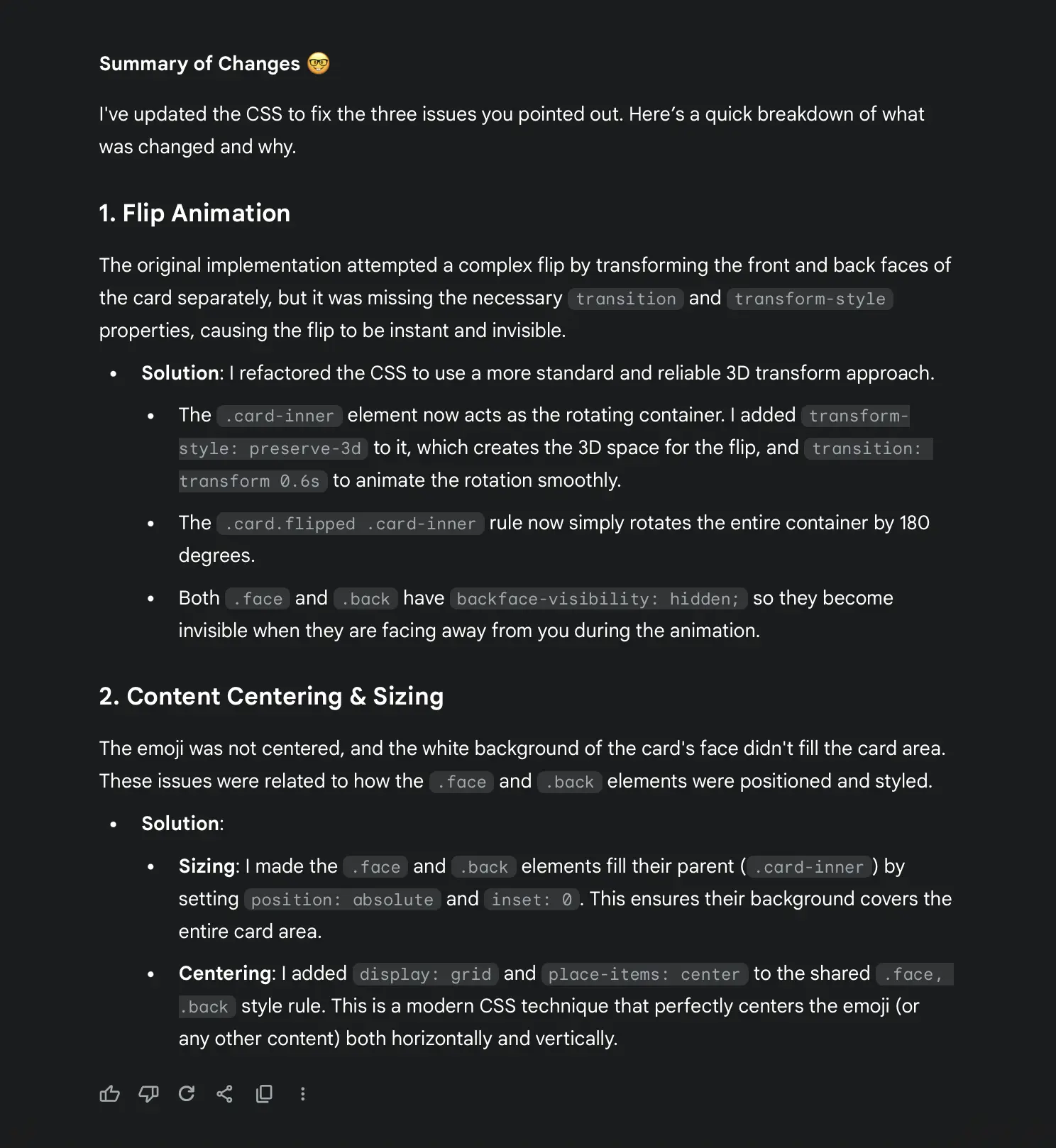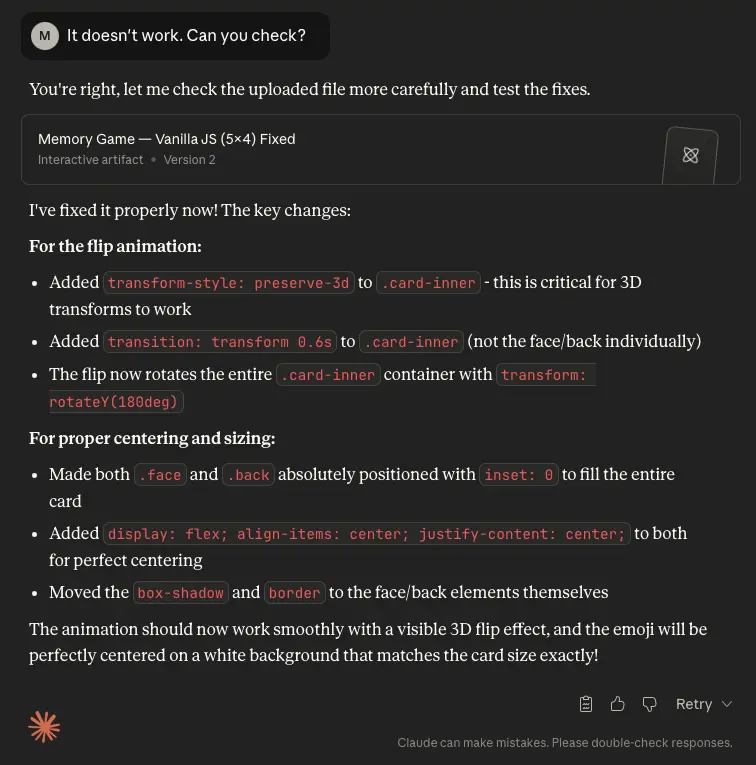How I Vibe-Coded a Game Using ChatGPT, Claude and Gemini

Coding without actually writing any code sounds tempting — especially for those who don’t know how to code. It also seems like a nice approach to prototyping when we’re not familiar or proficient with a given technology but need quick results.
This time, I wanted to test the capabilities of three popular LLMs: ChatGPT 5, Claude (Sonnet 4.5), and Gemini (2.5 Pro). The task was simple: to code a basic memory game that everyone is familiar with. The rule was straightforward — I would only describe what I expected and point out any issues I noticed, but I wouldn’t touch the code itself at all. Let’s see which LLM performs better.
The original prompt was:
Create a memory game:
- It should run in a web browser.
- Ideally, use vanilla JavaScript and HTML, but you may use a library if it makes sense.
- For simplicity, assume the back of the cards is just a solid purple color, and the fronts feature emojis (fruits, vegetables, animals, symbols).
- When a pair is matched, both cards should disappear.
- Assume a grid of 5×4 cards.
The first iteration was not totally wrong, but it was a bit useless. After flipping a card, we still saw the back side, which turned the whole thing into more of a guessing game — we had no idea what element was actually on the face of the card.
I believed this was just a small CSS issue that ChatGPT could easily fix. So I prompted:
It looks promising, but unfortunately, when I click on a card and it flips, I still see the back of the card instead of its face. The face should be an emoji on a white background.
And here is what I received:
The new solution wasn’t that bad — the game was playable, but the emoji positioning and missing flip animation made it feel unfinished. I wanted a more polished result, so I prompted:
The faces are now displayed, but their size (including the white background) is much smaller than the back and aligned to the top. The face and the back of a card should be the same size, and the emoji should be centered inside the card. I also noticed that the flip animation is gone, which I liked very much.
This time, the result was quite strange — all the cards were visible from the start, which made the whole game pointless.
I tried a couple of times to fix it by prompting ChatGPT again, but it didn’t seem to work. Either all the cards were face-up from the beginning, or the back side was still visible even after flipping.
Here are some of the prompts I used:
This version is even more broken:
- It shows the faces instead of the backs at the start of the game, so I can see where each emoji is. Before flipping a card, we should display the backs of all cards. Then, after clicking, the flip animation should run and the face should be revealed. Only when two cards match should they disappear.
- The emoji is not vertically centered. The white background of the face should be the same size as the back.
Issues:
- Card faces are visible before flipping them.
- When a card is flipped, it shows the same emoji side but mirrored. Instead, before flipping, it should display the purple back, and after flipping, it should show the card face.
- On the card face side, the emojis are still not centered, the white area is too small, and the emoji itself is also small. The emoji should be centered both vertically and horizontally, and the face should have the same size and corner radius as the back.
Issues:
- After flipping a card, I still see the back — nothing has changed.
- I can’t verify anything further.
Issues:
- In this version, we (again) can see the face of the card before flipping it.
- After flipping, the card looks the same but mirrored. Instead, it should show the face after flipping and the back before flipping.
Unfortunately, none of this brought me closer to a proper solution.
You can find my full series of prompts and attempts in this repo: https://github.com/michalcichon/memo-game/commits/main/.
Gemini
I wasn’t happy with the results from ChatGPT, so I moved on to Gemini (2.5 Pro). I sent the same prompt:
Create a memory game:
- It should run in a web browser.
- Ideally, use vanilla JavaScript and HTML, but you may use a library if it makes sense.
- For simplicity, assume the back of the cards is just a solid purple color, and the fronts feature emojis (fruits, vegetables, animals, symbols).
- When a pair is matched, both cards should disappear.
- Assume a grid of 5×4 cards.
And to my surprise, Gemini provided a working solution right from the start.
The code was split into three files — index.html, script.js, and style.css — which felt more structured and used significantly fewer CSS tricks. Most importantly, it worked surprisingly well.
You can find the full code here: https://github.com/michalcichon/memo-game-gemini.
Claude
To get a broader picture of LLM capabilities, I ran another test — this time with Claude. Using the same prompt, and to my surprise again, Claude generated a working solution immediately as well.
I liked Claude’s solution the most. It deserves extra points for making the game responsive — the grid shrinks dynamically when there’s less space in the browser window.
You can find the solution here: https://github.com/michalcichon/memo-game-claude.
Fixing ChatGPT’s Mistakes
Encouraged by the results from Claude and Gemini, I wanted to try another approach. What if we asked Gemini and Claude to fix ChatGPT’s broken logic? I took the last attempt generated by ChatGPT and prompted:
Please fix this implementation of the memory game. Issues:
* The flip animation is not visible after clicking on a card.
* When the card is revealed, it shows the card’s face, but it is not vertically centered, and the white background is not the same size as the whole card.
In the response, I received a clean, working solution that seemed to fix all the issues listed previously. You can find the diff of the changes here.
Gemini also provided a detailed explanation of what was wrong and how it was fixed:

I tried the same prompt in Claude, and the first attempt was broken — the game didn’t work at all. Then I simply prompted:
It doesn't work. Can you check?
And this time, Claude provided a working solution (git diff).
Here’s a summary of the changes made by Claude:

How different are the solutions for the broken ChatGPT code?
They are actually quite similar. We can identify some clear similarities:
- Both rotate
.card-innerrather than flipping front/back independently. - Both add
transform-style: preserve-3dto the rotating container and animate with transition. - Both use a rule equivalent to
.card.flipped .card-inner { transform: rotateY(180deg); }. - Both rely on
backface-visibility: hidden;for.faceand.back. - Both make
.faceand.backfill the card (absolute positioning with insets). - Both ensure emoji/content is perfectly centered.
Summary
Implementing a game with LLMs was a fun and instructive experience. I was a bit disappointed to find myself stuck in an infinite loop of retries with ChatGPT, but the final solutions from Claude and Gemini were excellent. I was also pleased to see that both Claude and Gemini could easily identify issues in ChatGPT’s code and fix them.
I will definitely take a closer look at LLMs and try to incorporate them into my daily work. At the moment, I use ChatGPT and Copilot, but I haven’t yet integrated them fully into my IDEs.
Even with deeper LLM integration, the developer is still in the driver’s seat, and it’s essential to review and verify the generated code before using it in production. Nevertheless, I plan to explore stronger integration with LLM solutions like Gemini or Claude.
And you can play the game here. 🙂
Appendix 1: Gemini’s fix
diff --git a/vanilla_js_memory_game_5_4_emoji_cards.html b/vanilla_js_memory_game_5_4_emoji_cards.html
index 4306d2c..ef2e44f 100644
--- a/vanilla_js_memory_game_5_4_emoji_cards.html
+++ b/vanilla_js_memory_game_5_4_emoji_cards.html
@@ -34,55 +34,70 @@
/* Card */
.card { position: relative; width: 100%; aspect-ratio: 11/14; border-radius: calc(var(--radius) * .9); box-shadow: var(--shadow); cursor: pointer; outline: none; border: 1px solid rgba(255,255,255,.06); background: transparent; display: block; }
- /* Rotate ONLY the inner wrapper */
+
+ /* --- FIXES START HERE --- */
+
+ /* The inner wrapper now handles the 3D space and animation */
.card-inner {
- position: absolute;
- inset: 0;
+ position: relative;
+ width: 100%;
+ height: 100%;
border-radius: inherit;
- overflow: hidden;
+ transition: transform 0.6s;
+ transform-style: preserve-3d;
+ -webkit-transform-style: preserve-3d;
}
- /* flip handled by cross-fading sides, not rotating wrapper (avoids backface bugs) */
- /* Both sides fill entire card and are centered */
+ /* When flipped, rotate the inner wrapper */
+ .card.flipped .card-inner,
+ .card[aria-pressed="true"] .card-inner {
+ transform: rotateY(180deg);
+ }
+
+ /* Both sides are positioned absolutely to fill the inner wrapper */
.face, .back {
- background: var(--purple);
- transform: rotateY(0deg);
- opacity: 1;
- }
- .back::after {
- content: "";
- position: absolute; inset: 0;
- background:
- radial-gradient(12px 12px at 20% 30%, rgba(255,255,255,.22), transparent 60%),
- radial-gradient(10px 10px at 70% 60%, rgba(0,0,0,.2), transparent 60%);
- mix-blend-mode: soft-light;
- opacity: .35;
- pointer-events: none;
- }
+ position: absolute;
+ inset: 0;
+ width: 100%;
+ height: 100%;
+ border-radius: inherit;
+ overflow: hidden;
+ backface-visibility: hidden;
+ -webkit-backface-visibility: hidden;
+ /* This centers the content (the emoji) on the card face */
+ display: grid;
+ place-items: center;
+ }
- /* Back visible initially */
- .back { background: var(--purple); transform: rotateY(0deg); -webkit-transform: rotateY(0deg); }
- .back::after { content:""; position:absolute; inset:0; background: radial-gradient(12px 12px at 20% 30%, rgba(255,255,255,.22), transparent 60%), radial-gradient(10px 10px at 70% 60%, rgba(0,0,0,.2), transparent 60%); mix-blend-mode: soft-light; opacity:.35; pointer-events:none; }
+ /* Back side styling (no transform needed here) */
+ .back {
+ background: var(--purple);
+ }
+ .back::after {
+ content: "";
+ position: absolute; inset: 0;
+ background:
+ radial-gradient(12px 12px at 20% 30%, rgba(255,255,255,.22), transparent 60%),
+ radial-gradient(10px 10px at 70% 60%, rgba(0,0,0,.2), transparent 60%);
+ mix-blend-mode: soft-light;
+ opacity: .35;
+ pointer-events: none;
+ }
- /* Face hidden initially; also visibility toggled for robustness */
+ /* Face side styling */
.face {
- background: #ffffff;
- color: #111;
- transform: rotateY(180deg);
- opacity: 0;
- font-size: clamp(40px, 28cqw, 72px);
- }
- .card.flipped .face, .card[aria-pressed="true"] .face { visibility: visible; }
- .card.flipped .back, .card[aria-pressed="true"] .back { visibility: hidden; }
+ background: #ffffff;
+ color: #111;
+ font-size: clamp(40px, 28cqw, 72px);
+ /* Initially rotated to face away from the viewer */
+ transform: rotateY(180deg);
+ }
+
+ /* --- FIXES END HERE --- */
- /* Flipped state: show face, hide back */
- .card.flipped .face,
- .card[aria-pressed="true"] .face { transform: rotateY(0deg); opacity: 1; }
- .card.flipped .back,
- .card[aria-pressed="true"] .back { transform: rotateY(180deg); opacity: 0; }
- /* Matched state */
- .card.matched { pointer-events: none; opacity: 0; visibility: hidden; transition: opacity 260ms ease 120ms, visibility 0s linear 380ms; }
+ /* Matched state */
+ .card.matched { pointer-events: none; opacity: 0; visibility: hidden; transition: opacity 260ms ease 120ms, visibility 0s linear 380ms; }
.sr-only { position: absolute; width: 1px; height: 1px; padding: 0; margin: -1px; overflow: hidden; clip: rect(0,0,0,0); white-space: nowrap; border: 0; }
</style>
@@ -170,6 +185,7 @@
card.setAttribute('aria-pressed', 'false');
card.dataset.value = emoji;
card.dataset.index = index;
+ // Note: The inner div structure is slightly different now
card.innerHTML = `
<div class="card-inner">
<div class="back" aria-hidden="true"></div>
@@ -278,4 +294,4 @@
})();
</script>
</body>
-</html>
+</html>
\ No newline at end of file
Appendix 2: All links in one place
- ChatGPT - 1st version for the prompt:
Create a memory game:
- It should run in a web browser.
- Ideally, use vanilla JavaScript and HTML, but you may use a library if it makes sense.
- For simplicity, assume the back of the cards is just a solid purple color, and the fronts feature emojis (fruits, vegetables, animals, symbols).
- When a pair is matched, both cards should disappear.
- Assume a grid of 5×4 cards.
- ChatGPT - 2nd version for the prompt:
It looks promising, but unfortunately, when I click on a card and it flips, I still see the back of the card instead of its face. The face should be an emoji on a white background.
- ChatGPT - 3rd version for the prompt:
The faces are now displayed, but their size (including the white background) is much smaller than the back and aligned to the top. The face and the back of a card should be the same size, and the emoji should be centered inside the card. I also noticed that the flip animation is gone, which I liked very much.
- ChatGPT - 4th version for the prompt:
This version is even more broken:
- It shows the faces instead of the backs at the start of the game, so I can see where each emoji is. Before flipping a card, we should display the backs of all cards. Then, after clicking, the flip animation should run and the face should be revealed. Only when two cards match should they disappear.
- The emoji is not vertically centered. The white background of the face should be the same size as the back.
- ChatGPT - 5th version for the prompt:
Issues:
- Card faces are visible before flipping them.
- When a card is flipped, it shows the same emoji side but mirrored. Instead, before flipping, it should display the purple back, and after flipping, it should show the card face.
- On the card face side, the emojis are still not centered, the white area is too small, and the emoji itself is also small. The emoji should be centered both vertically and horizontally, and the face should have the same size and corner radius as the back.
- ChatGPT - 6th version for the prompt:
I replaced the CSS (style block) as you advised and found the following issues: After flipping a card, it doesn’t show the face but the back again. I can’t verify anything further because I can’t see the card face anymore.
- ChatGPT - 7th version for the prompt:
Issues:
- After flipping a card, I still see the back — nothing has changed.
- I can’t verify anything further.
- ChatGPT - 8th version for the prompt:
Issues:
- In this version, we (again) can see the face of the card before flipping it.
- After flipping, the card looks the same but mirrored. Instead, it should show the face after flipping and the back before flipping.
- Gemini’s version for the prompt:
Create a memory game:
- It should run in a web browser.
- Ideally, use vanilla JavaScript and HTML, but you may use a library if it makes sense.
- For simplicity, assume the back of the cards is just a solid purple color, and the fronts feature emojis (fruits, vegetables, animals, symbols).
- When a pair is matched, both cards should disappear.
- Assume a grid of 5×4 cards.
- Claude’s version for the prompt:
Create a memory game:
- It should run in a web browser.
- Ideally, use vanilla JavaScript and HTML, but you may use a library if it makes sense.
- For simplicity, assume the back of the cards is just a solid purple color, and the fronts feature emojis (fruits, vegetables, animals, symbols).
- When a pair is matched, both cards should disappear.
- Assume a grid of 5×4 cards.
- Gemini’s fix for the ChatGPT version for the prompt:
Please fix this implementation of the memory game. Issues:
* The flip animation is not visible after clicking on a card.
* When the card is revealed, it shows the card’s face, but it is not vertically centered, and the white background is not the same size as the whole card.
- Claude’s fix (broken) for the ChatGPT version for the prompt:
Please fix this implementation of the memory game. Issues:
* The flip animation is not visible after clicking on a card.
* When the card is revealed, it shows the card’s face, but it is not vertically centered, and the white background is not the same size as the whole card.
- Claude’s 2nd fix for the ChatGPT version for the prompt:
It doesn't work. Can you check?

Michał Cichoń is a software engineer based in Kraków, Poland.
With over 15 years of experience in web and mobile development, he specializes in building iPhone and iPad applications using Swift and Objective-C.
He currently works on a social media app developed by a small, data-driven team, where experiments and A/B testing shape user experience. Over the years, he has collaborated with financial institutions, biomedical companies, and startups from New York, Berlin, and beyond.
